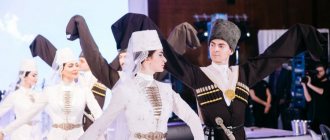A Tatar wedding is an amazingly beautiful and original celebration in accordance with Sharia law, since the majority of Tatars are Muslims. The rich national customs of one of the most ancient peoples on earth turn this event into a bright, original holiday.
Historical and national features of the Tatar wedding
Rich national traditions make a Tatar wedding interesting, original, and has retained its innermost zest. Previously, weddings were celebrated in November, after agricultural work was completed.
The basic Islamic canons are strict and laconic. In the old days, parents of young people themselves decided the fate of their children. The choice, agreements, and organization of the wedding itself were carried out by the parents with the help of matchmakers. The young people were only notified of the decision. Wedding celebrations were held separately for men and separately for women.
Strict Muslim laws require young people to behave modestly at the celebration, without showing feelings. The bride is not allowed to talk, drink or eat. In some places, she was not even present at the festive table, but was waiting for the groom in a specially decorated room. After the wedding, the young wife was not allowed to leave the house for forty days.
National wedding features contain many bright, mysterious rituals:
- Matchmaking. Engagement. Collusion. Parents meet, get acquainted and discuss terms. At the same time, gifts are exchanged. The newlyweds may not be present at the matchmaking ceremony.
- Kalym. This is a bride price; the number of gifts is agreed upon jointly by the parents. The ransom included household items, furniture and household items, dresses, scarves, and money. Traditionally, the bride ransom is performed in the Tatar language.
- Kiyallipier. Comic tests that bridesmaids prepare for the groom. They are always fun and funny, but they require from the groom not only skill and strength, but also material resources.
- Nikah. A religious ceremony confirming a Muslim marriage in accordance with Sharia law, performed by a mullah. Consists of reading the Koran, prayers, spiritual instructions. Only Muslims dressed in national dresses and with their heads covered are invited, although the bride and groom may not be present at this main ceremony. But before the nikah, the young people should not be left alone.
- Tui. This is actually the Tatar wedding itself, which lasts several days in different houses. First, they go for a walk with the bride's parents and relatives, and then the groom takes the bride to his parents' house. Here they greet her hospitably and warmly, presenting her with rich gifts. A special sign of the bride’s warm welcome is the soft pillows that are placed under her feet. Another interesting ritual is associated with wishes for wealth, to become a good housewife - the bride’s hands are dipped in flour. The scenario for such festivities is usually typical.
All ceremonial wedding ceremonies are beautiful, unforgettable and colorful. Before the wedding, in both houses of the parents of the bride and groom, a mysterious ritual ceremony was held to commemorate the souls of deceased relatives. This is how a blessing for marriage was asked. Respect for elders was also expressed in the fact that, according to ancient tradition, wedding feasts are organized according to the ages of the guests, then more than one scenario is prepared.
Marriage by matchmaking: wedding procedure
Matchmaking
First, the groom's relatives proposed to the bride's parents. Then, during the matchmaking, the date of the celebration and the bride price were set - these are gifts with which the bride price is paid in a Tatar wedding (by the way, among the Tatars it is called “kalyn”). What was included in the bride price? These were household items, bed linen, hats, clothes and shoes. Money was also transferred to prepare the bride's dowry and a contribution was made with food for the festive banquet.
Then a conspiracy was carried out: during it, the groom’s side handed over money, and the bride’s side handed over a towel or tablecloth as a gift. The bride's relatives who participated in the conspiracy were necessarily treated to various delicacies.
Nikah ritual
In a Tatar wedding, nikah (or nikah tui) is an official part of the celebration in accordance with Sharia. The nikah was held in the bride's house, the groom's parents were the main guests. The groom's relatives brought bride price and treats with them to the wedding, if they had not already given them before. The roles of all relatives participating in the celebration were agreed upon in advance: some of the bride’s relatives brought delicacies, while others invited the groom’s relatives to their place, taking care of them in every possible way and providing them with lodging for the night, since the wedding took place for more than one day.
The nikah ceremony itself had to be conducted by a mullah, who wrote down the conditions of marriage in a special book. At this time, wedding expenses were listed on the part of the groom and it was stipulated what amount would be paid to the wife if the husband wanted to divorce. The presence of the young people was not required. And who then answered the cherished question “Do you agree”? The witnesses were responsible for the bride, and his father was responsible for the groom. Before this, witnesses asked about the consent of the bride, who was behind the curtain or in another room. Having heard the agreement of both parties, the mullah began to read the Koran in a solemn atmosphere. And only after the completion of the nikah ceremony did the wedding banquet begin.
Festive banquet
- According to tradition, the celebration was celebrated at one long table, at the head of which the newlyweds sat, with the bride always on the right. The bride's parents sat on the groom's side, and the groom's parents, respectively, on the bride's side. On both sides, after the parents, there were witnesses, and after them, the relatives of the bride and groom.
- The Tatars had no alcohol at the wedding - only fruit drinks, compotes and other non-alcoholic drinks. Lastly, tea was served, and with it the traditional dish chak-chak - this is an alternative to the usual wedding cake. By the way, chak-chak, which is also called kyzkumeche, was also served during the nikah ritual. It was usually the bride's side who prepared the sweet delicacy.
- In addition, national dishes of Tatar cuisine were always present on the table: gubadia (a round multi-layered pie), ochpochmaki (something like pies, but only in the shape of triangles), the well-known belyashi, etc. The obligatory dish was the festive goose, which was usually brought relatives of the groom. It is also necessary to note the existence of special rules for serving and cutting dishes. During this process, the newlyweds were presented with money and gifts.
Wedding festivities
The guests walked at the wedding in the bride's house for two or three days, and after they left, preparations began for the groom's arrival. The newlyweds' room was decorated with items from the bride's dowry; the couple was to spend several days here. The period of the groom's first arrival is notable for the fact that he had to pay a bride price both for entry into the courtyard and for the opportunity to see his beloved, as well as for those who heated the bathhouse and made the bed. The bride was presented with a particularly valuable gift. The duration of the groom's first visit ranged from two to six days (it depended on the bride price), after which he visited his beloved on Thursdays and left the next morning.
When the bride price was fully paid, the young wife could finally move into her husband’s house. And here, too, all traditions were strictly observed: the husband’s mother greeted her daughter-in-law with friendly words and spread a fur coat or pillow under her feet. Then the daughter-in-law had to hang up the towel and taste a crust of bread with butter and honey - so that she would be livable, soft and flexible.
The young wife also had to immerse her hands in flour - so that the family would always have prosperity. Also, the customs and traditions of a Tatar wedding involved decorating the house with items from the bride’s dowry and showing the young beauty the road leading to the spring. The daughter-in-law needed to give gifts to all the relatives involved in this process.
After the wife moved, the banquet continued in the houses of the parents and relatives of the husband. The young couple went on a visit to the house of the wife's parents, and they visited the groom's house.
Modern Tatar wedding
The very scenario of a modern Tatar wedding involves a traditional feast with several national rituals and rites. They are seated at a common table, in the center of which is the groom and to the right of him, the bride, on one side are the groom's relatives, on the other - the bride. Everyone is in elegant clothes, especially luxurious and expensive scarves and dresses for women. After all the guests have met each other, the toastmaster opens the festive celebration. The ceremonial scenario is accompanied by speeches and toasts. Wedding congratulations in Tatar are welcome. Muslims always appreciate kind, well-aimed words of wishes at the festive table.
The celebration scenario does not end with a banquet; there are still many festivities ahead with dancing, games and fun. There is a ritual associated with the newlyweds visiting the bathhouse after the wedding feast, as a symbol of purification.
Preparing a feast is a hospitable and labor-intensive phenomenon of Tatar life. All wedding dishes were prepared according to special recipes by skilled cooks. The preparation and distribution of treats was accompanied by ritual rules. For main courses, baked goose, fried meat with vegetables, and pilaf are usually prepared. Gubadiya wedding cake and many other national pastries are served. The main sweet treat is the incomparable chak-chak cake. Everyone loves this crunchy treat.
Currently, the general wedding scenario includes a ceremonial registration of marriage, which takes place in the registry office. After official events, gifts are exchanged. Wedding gifts are presented in a wide variety of ways, but always generous and friendly. The main gift is given by the groom to the bride, who in return presents him with her own handicrafts. Parents on both sides also exchange gifts. It is customary to give gifts to all guests at a Tatar wedding. Such gifts are divided into men's and women's.
Wedding Tatar clothing
Preparation of wedding attire begins long before the celebrations themselves. The groom's side gave the bride a piece for the dress in advance. In response, she sewed a shirt for her betrothed. However, there were no strict traditions in the relationship between color and style for wedding suits.
Nowadays, newlyweds choose a traditional wedding dress: a white dress and suit. Various silhouettes and models are used. The options for brilliant finishing shock and enchant the owner of the dress. Classic silk adds chic and sophistication to the newlyweds' costumes.
Muslim dresses for nikah require compliance with strict conditions for the style. The fabric is selected dense, the dress model should hide the bride’s figure. A scarf or shawl decorated with flowers is beautifully tied around the head.
Tatars living throughout all territories have some differences in language and customs. But still, this is a single ancient nation that has preserved its culture. Today it is customary to revive ancient wedding rites and rituals everywhere, as observed among the Tatars. Despite the fact that recently there has been a unification of weddings of different nations, common features are being established, yet the Tatar wedding retains its originality and makes it original.
Other forms of marriage
Bride kidnapping
Other forms of marriage among the Tatars are less common. As for kidnapping the bride, grooms resorted to this ancient and, frankly speaking, primitive type of marriage extremely rarely - when they could not reach an agreement. The kidnapped bride and her parents agreed to the marriage to avoid shame.
Despite the fact that kidnapping is savagery in itself, there were nevertheless some rules here. For example, widowers and mature grooms did not allow themselves to do this; it was forbidden to kidnap widows, strangers and girls from among relatives. In addition, after the abduction, the groom had to pay a much larger amount of bride price, and the nikah ceremony was carried out according to a simplified scheme.
It also happened that the kidnapping was staged by mutual consent of the parties - as a tribute to ancient tradition. This made it possible to significantly reduce the financial costs of holding the celebration.
Voluntary departure to the groom
This form of marriage became most widespread at the beginning of the 20th century and was based on the mutual desire of the parties, but was condemned by society. This form had its advantages: there was no need to wait until the older brother or sister got married; the terms of the agreement were dictated by the groom's parents, which significantly reduced the size of the bride price.
Basically, both the kidnapping and the voluntary departure of a girl to her groom were condemned by public opinion, so such forms of marriage were rare at the turn of the 19th – 20th centuries.
Changes in public life in general influenced the traditions of the Tatar wedding. The beginning of the last century was a difficult period. The devastation following the Civil War meant that wedding customs were less strictly observed. In the period from the 30s to the 60s, traditional Tatar wedding rituals were reduced and new ones emerged. However, the main points have been preserved and are observed to this day - this is clear from the video of the customs of the Tatar wedding.
We recommend reading about a beautiful Turkish wedding. And what is the beauty of a bright Ukrainian wedding, read here.











